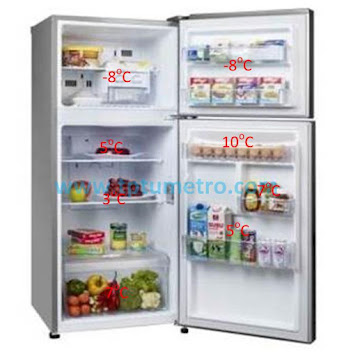Storing Food in the Refrigerator
Storing Food in the Refrigerator.
Refrigerator or refrigerator is an electrical device that is already common in
society. Almost every house already has it, whether it is a one-door
refrigerator, two-door, or more than two doors. We are used to putting food in
the refrigerator to keep it fresh and last longer. But where is the right place
in the refrigerator for each type of food? Let's discuss the temperature in the
refrigerator so that we can adjust where we will put certain types of food.
The freezer section is not
allowed to store packaged drinks, fruit and vegetables. These foodstuffs should
not be stored at cold temperatures below 0oC. Why?
We see the nature of water which when cooled from 100oC to 4oC its volume will shrink. And if we cool it again to 0oC the volume will increase. This is the cause.
If the packaged drink is
cooled to a temperature of 0oC, the volume of the liquid in it will
enlarge so that the packaging can be damaged (broken). The same goes for
vegetables and fruit if they are cooled to 0oC. We can try cooling
the apples in the freezer until they freeze. Physically the apples will look
fresh and hardened. Let's try to put it at room temperature and wait a while.
After the temperature of the apple rises and the water in the fruit has melted,
the apple will be mushy/wrinkled. This is caused because the water in the apple
expands and spoils the fruit flesh.
Storing meat
Meat that will be stored in
the refrigerator should be selected that is still new and fresh. In a
refrigerator that has a meat tray, meat can be stored for up to seven days. The
temperature is placed in a place with a temperature of -6oC or
lower.
Storing cooked food
After the food is finished
cooking, a small amount can be immediately put in the refrigerator in a suitable
place. If the food is not going to be eaten in a few days, it is best to wrap
and freeze the food.
Saving fish
Fish is an item that quickly
rots due to germs. Fish can be stored whole or in pieces after cleaning the
entrails. Fish should be wrapped in wax paper or plastic, so as not to smell
fish in the refrigerator. If you want to store it for a long time, the fish
must be frozen in the freezer at -15oC.
Storing milk
Milk that will be stored in
the refrigerator must be pure, clean, and fresh. After we buy whole milk, it
must be immediately heated to a temperature of 65oC for
approximately 25 minutes, to kill the germs in the milk (pasteurized), then
immediately cooled to 4-10oC, so that there is no chance for germs
to breed in it. .
Storing eggs
Before storing in the
refrigerator, eggs must be washed first to remove dirt and germs on the skin.
After drying and then stored on the egg rack (egg keeper) on the inside of the
refrigerator door. Eggs are arranged in a standing position, on the pointed
part facing up at a temperature of 10-16oC. Eggs must be kept dry
because eggs with wet shells develop mold and spoil.
Storing margarine, butter and cheese
Margarine comes from plants
while butter comes from animals. Margarine and butter in large cans, after
opening the cans, they must be wrapped before being stored on one of the
refrigerator shelves at a temperature of 16oC. For daily use in
small quantities, some of the margarine or butter can be stored in the butter
compartment.
Storing vegetables and fruit
Vegetables and fruit that
will be stored in the refrigerator should be selected that are new and fresh.
Before storing vegetables and fruit should be washed with cold water until
clean, to remove sand, dust, and other impurities. Vegetables and fruit should
be stored above their freezing point in a vegetable drawer or crisper at 4 - 7oC.
For better results, care should be taken so that there is always a small amount
of water left on the surface of vegetables and fruit. Bananas if stored below
13oC, the skin will be damaged and black spots will appear.

Tidak ada komentar:
Posting Komentar
Tulis komentar dengan bijak tanpa unsur SARA, Politik, dan Pornografi.